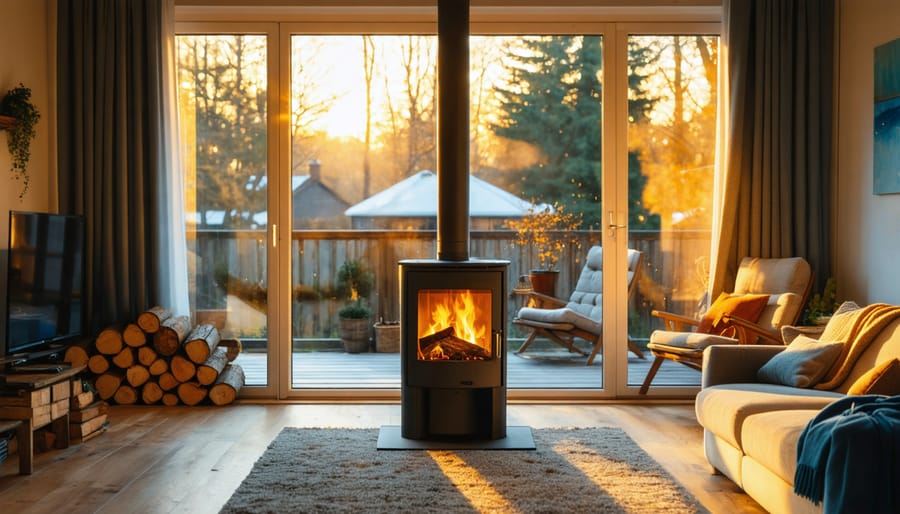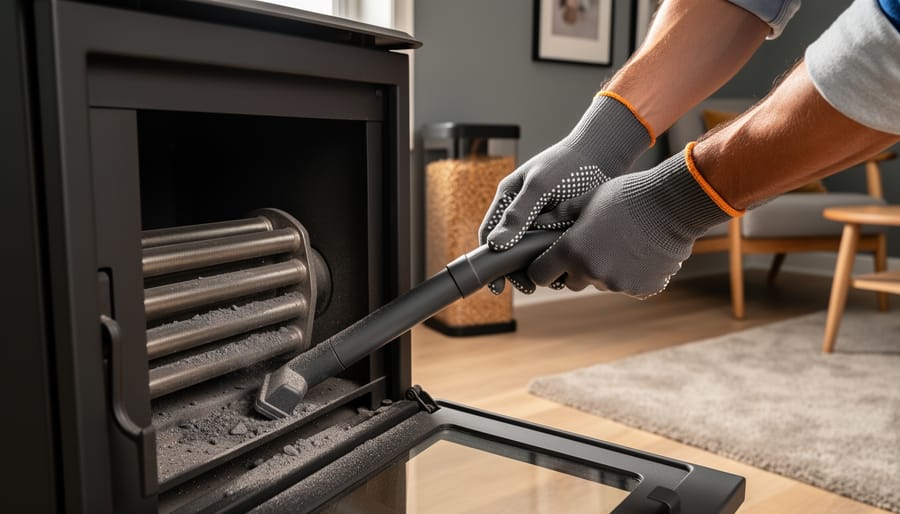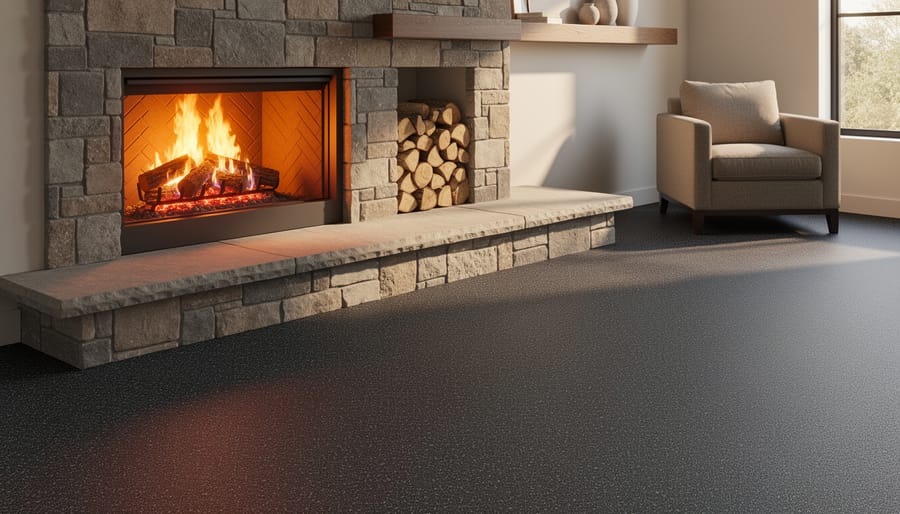**Slash your heating bills by 30-50% this winter** by exploring proven alternatives that deliver real warmth without breaking the bank. While your central heating system churns through energy dollars, strategic supplemental heating solutions can transform how you heat your home—and what you spend doing it.
**Layer your heating approach** instead of relying on a single expensive system. Think of home heating like dressing for cold weather: your primary system provides the base layer, while zone heating targets the rooms you actually use. A quality fireplace or wood stove can heat your main living areas for a fraction of furnace costs, while portable electric heaters warm bedrooms only when occupied.
**Prioritize passive solar strategies first**—they’re free once implemented. South-facing windows can reduce heating needs by 25% when you remove heavy curtains during sunny winter days and add thermal backing at night. Combine this with draft-sealing around doors and windows, and you’ve already cut significant waste.
**Consider wood and pellet heating as a lifestyle upgrade**, not just a cost-cutting measure. Modern wood stoves and pellet systems offer 75-85% efficiency while creating the ambiance that makes a house feel like home during cold months. These aren’t your grandfather’s smoky fireplaces—today’s EPA-certified options burn clean while providing sustainable, renewable heat that insulates you from volatile energy prices.
The right combination depends on your home’s layout, your budget, and how much involvement you want in your heating routine.
Why Homeowners Are Moving Away from Traditional Heating
If you’ve noticed your heating bills climbing higher each winter, you’re not alone. Homeowners across the country are experiencing sticker shock as energy costs continue their upward trajectory. What used to be a manageable monthly expense has become a significant strain on household budgets, with some families seeing their heating costs double or even triple over the past few years.
But rising costs aren’t the only reason people are exploring alternatives to traditional furnaces and baseboard heating. There’s a growing awareness that our heating choices have real environmental consequences. Traditional heating systems often rely on fossil fuels, contributing to carbon emissions and environmental degradation. For homeowners who care about their ecological footprint, finding cleaner, more sustainable heating solutions has become a priority—not just for the planet, but for their own peace of mind.
Here’s something many people don’t realize about conventional heating: you’re often paying to heat rooms you barely use. Think about it—your furnace works overtime to maintain the same temperature throughout your entire home, whether you’re in your bedroom at night or gathered in the living room during the day. That’s where zone heating comes in as a game-changer.
Zone heating allows you to warm specific areas of your home exactly when and where you need it. Instead of heating an entire 2,000-square-foot house to keep your family comfortable in a 300-square-foot living room, you can focus your heating efforts strategically. This approach isn’t just more efficient—it can dramatically reduce your energy consumption and costs.
The combination of financial pressure, environmental consciousness, and the appeal of targeted efficiency is driving a real shift in how we think about home heating. Today’s alternatives offer homeowners the flexibility to create warmth that’s both economical and sustainable, transforming heating from a necessary burden into a lifestyle choice that aligns with their values and budget.
Wood-Burning Solutions: Classic Warmth with Modern Efficiency
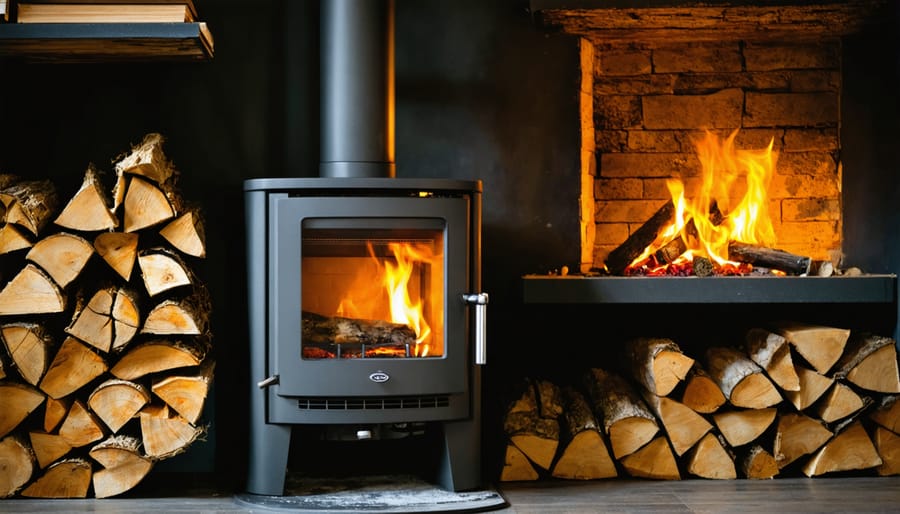
EPA-Certified Wood Stoves vs. Traditional Fireplaces
If you’re drawn to the crackling ambiance of a wood fire but want meaningful heat output, understanding the difference between EPA-certified wood stoves and traditional fireplaces is essential for making a smart heating decision.
Traditional open fireplaces are wonderful lifestyle elements that create a cozy focal point in your home, but they’re notoriously inefficient heaters. Most traditional fireplaces operate at only 10-20% efficiency, meaning up to 90% of the heat literally goes up the chimney. Even worse, they can actually pull warm air from your home, sometimes making adjacent rooms colder rather than warmer.
EPA-certified wood stoves, on the other hand, deliver 70-85% heating efficiency—a dramatic improvement that translates directly to lower fuel costs and tangible warmth throughout your living space. These modern units burn wood more completely, producing significantly less smoke and particulate matter, making them genuinely eco-friendly heating solutions that align with contemporary environmental standards.
The environmental difference is striking: EPA-certified stoves emit up to 90% less pollution than traditional fireplaces, addressing air quality concerns while providing sustainable warmth. They use approximately one-third the wood for the same heat output, reducing both your fuel expenses and environmental footprint.
If you’re currently relying on a traditional fireplace for supplemental heat, upgrading to an EPA-certified wood stove or insert could transform it from a charming but inefficient feature into a legitimate heating alternative that substantially reduces your reliance on central heating systems during colder months.
What You Need to Know About Wood Sourcing and Storage
Success with wood heating starts long before you strike the first match—it begins with smart sourcing and proper storage. If you’re considering wood as an eco-friendly heating solution, understanding these fundamentals will save you money and frustration while ensuring clean, efficient burns.
**Getting Your Wood Supply**
You have several options for obtaining firewood. Purchasing seasoned wood from reputable dealers is the most convenient choice, though it costs more upfront. Buying green (unseasoned) wood offers significant savings—sometimes 30-50% less—but requires patience. Some homeowners split their own wood from fallen trees or purchased logs, which provides excellent exercise and maximum cost savings. Check local classifieds, tree removal services, and municipal programs that often offer free or low-cost wood from storm cleanup.
**The Seasoning Process**
Properly seasoned firewood contains less than 20% moisture content and burns hotter, cleaner, and more efficiently than green wood. Seasoning typically takes 6-12 months depending on wood species and climate. Split your wood to 3-6 inches in diameter to accelerate drying—smaller pieces season faster.
**Storage Best Practices**
Stack firewood in a sunny, well-ventilated area at least 20 feet from your home to prevent pest problems. Elevate wood off the ground using pallets or lumber to prevent moisture absorption. Cover only the top third of your stack, allowing sides to breathe—completely covered wood traps moisture. Store a week’s supply indoors to ensure consistently dry fuel ready for your fireplace.
Pellet Stoves: The Set-It-and-Forget-It Alternative
If you’re drawn to the charm of a wood-burning stove but cringe at the thought of splitting logs and tending fires constantly, pellet stoves might be your perfect match. These innovative appliances bridge the gap between traditional wood heating and modern convenience, offering homeowners an automated heating solution that still delivers that authentic warmth you’re seeking.
Unlike their wood-burning cousins, pellet stoves run on compressed wood pellets—small, uniform cylinders made from recycled sawdust and wood waste. This makes them an eco-friendly heating solution that repurposes material that would otherwise end up in landfills. The beauty lies in their automation: simply fill the hopper with pellets, set your desired temperature, and let the stove do the work. Most models feature automatic igniters and programmable thermostats, allowing you to wake up to a warm home without fumbling with kindling at dawn.
The convenience factor extends to fuel management too. Pellets come in standardized 40-pound bags, readily available at hardware stores, farm supply outlets, and big-box retailers throughout the heating season. They’re easy to stack and store, taking up considerably less space than cordwood. You can expect to pay between $200 and $300 per ton, with most homes requiring two to three tons for a typical heating season, depending on climate and usage patterns.
Operating costs generally fall between traditional wood stoves and electric heating, making pellet stoves an economically sensible middle ground. You’ll also appreciate the cleaner burn—pellet stoves produce minimal ash and significantly less creosote buildup than wood stoves, translating to easier maintenance and safer operation.
However, there’s a catch: pellet stoves require electricity to run their augers, fans, and control systems. During power outages, you’ll need a backup generator or battery system to keep them operational. Maintenance is fairly straightforward but non-negotiable—you’ll need to empty the ash pan weekly, clean the burn pot regularly, and schedule annual professional servicing.
For homeowners wanting the ambiance of fire without the labor-intensive commitment, pellet stoves offer an appealing compromise that combines efficiency, sustainability, and comfort in one attractive package.

Gas Fireplaces and Direct Vent Systems
If you have access to natural gas or propane, a gas fireplace or direct vent system offers one of the most convenient heating alternatives available. These systems combine the ambiance of a real flame with impressive efficiency and minimal maintenance—no wood to haul, no ashes to clean, and operation at the flip of a switch or tap of a remote.
Direct vent gas fireplaces are particularly appealing because they draw combustion air from outside and exhaust directly through an exterior wall. This means they don’t compete with your home’s air supply and can be installed almost anywhere without requiring a traditional chimney. You’ll find options ranging from traditional fireplace inserts to sleek linear designs that complement modern interiors, making them both a functional heating solution and a lifestyle element that enhances your living space.
The efficiency of gas fireplaces has improved dramatically in recent years. Quality direct vent models now achieve 70-85% efficiency, converting most of their fuel into usable heat. While not quite matching the efficiency of some pellet stoves—you can compare monthly operating costs between systems—gas options eliminate the learning curve of operating pellet stoves or the physical demands of installing a pellet stove.
Gas fireplaces make the most financial sense when natural gas is readily available in your area. Natural gas remains one of the most affordable heating fuels in many regions, and installation costs for direct vent systems typically range from $3,500 to $7,000, depending on complexity and finish choices. Propane units work identically but require tank storage and typically cost more to operate long-term.
Ventless gas fireplaces offer another option with even lower installation costs, but approach these cautiously. While they’re highly efficient since no heat escapes through venting, they release combustion byproducts into your home. Many building codes restrict or prohibit them, and safety experts recommend limiting their use.
For homeowners seeking reliable supplemental heat with minimal effort, gas systems deliver comfort and ambiance while supporting your primary heating system during peak demand—ultimately helping manage those high heating bills without sacrificing your home’s warmth or style.
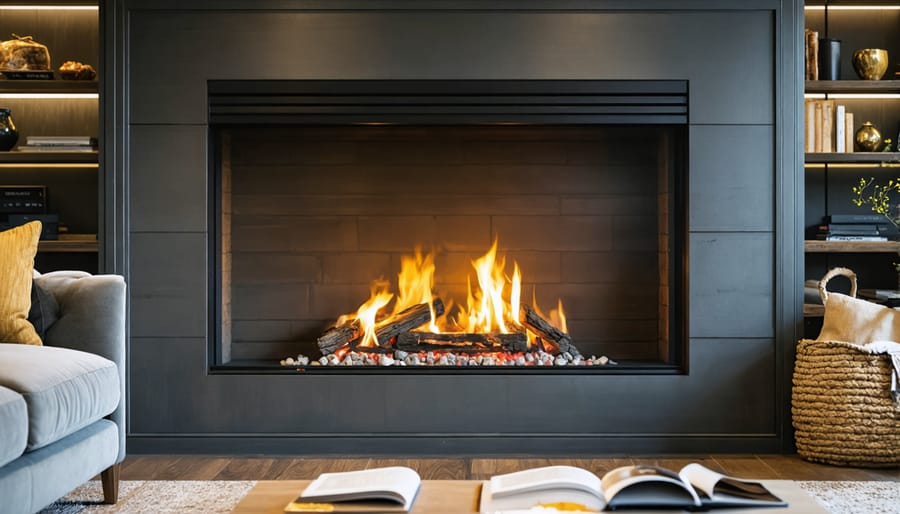
Electric Heating Alternatives That Don’t Break the Bank
Electric heating has come a long way from those clunky, energy-guzzling baseboard heaters your parents might remember. Today’s electric options offer smart, efficient ways to warm your home without sending your utility bills through the roof—especially when you embrace the power of zone heating.
**Infrared Heaters: Warmth That Feels Like Sunshine**
Infrared heaters work differently than traditional space heaters. Instead of warming the air (which rises and escapes), they emit radiant heat that warms people and objects directly, much like standing in sunlight on a cool day. This makes them incredibly efficient for the spaces you actually use. A quality infrared heater can warm a 200-square-foot room for about the same cost as running a few light bulbs. They’re perfect for home offices, bedrooms, or that chilly corner of your living room where you love to read.
**Electric Fireplaces: Ambiance Meets Efficiency**
Modern electric fireplaces have evolved beyond their tacky ancestors into stylish focal points that deliver both warmth and ambiance. They’re exceptionally efficient because 100% of the electricity converts to heat—no chimney means no heat loss. You can enjoy the cozy glow without heating the room, or use them as a supplemental heat source for spaces up to 400 square feet. Installation is a breeze, requiring only a standard outlet, and many models include thermostats and timers for smart energy management.
**Heat Pumps: The Game-Changer**
While requiring upfront investment, ductless mini-split heat pumps represent the most eco-friendly electric option available. They move heat rather than generate it, making them 2-3 times more efficient than traditional electric heating. Perfect for targeting specific zones, they can heat a room in winter and cool it in summer—true year-round comfort.
The secret to making electric heating affordable? Strategic zone heating. Heat only the rooms you’re using, and you’ll dramatically reduce costs while staying perfectly comfortable where it matters most.

Eco-Friendly Options: Bioethanol and Beyond
If you’re committed to reducing your carbon footprint while keeping your home cozy, eco-friendly heating alternatives deserve a serious look. These solutions combine modern lifestyle appeal with genuine environmental benefits, proving that warmth and sustainability can absolutely go hand-in-hand.
**Bioethanol fireplaces** have emerged as a game-changer for environmentally conscious homeowners. These sleek units burn clean bioethanol fuel—a renewable energy source derived from plant materials—producing real flames without the smoke, ash, or chimney requirements of traditional fireplaces. They’re incredibly versatile, available as wall-mounted units, freestanding models, or elegant tabletop versions that double as stunning décor pieces. While they won’t heat your entire home, they provide excellent supplemental warmth for specific rooms while creating that irresistible ambiance we all crave. The fuel burns cleanly with minimal emissions, and there’s no need for venting, making installation remarkably straightforward.
**Solar heating integration** represents another forward-thinking approach. Solar thermal panels can work alongside your existing heating system, using the sun’s energy to warm water or air that’s then circulated throughout your home. While the upfront investment is significant, many homeowners see substantial reductions in their heating bills over time, and various tax incentives can help offset initial costs.
For those ready to make a long-term commitment to sustainable heating, **geothermal systems** offer impressive efficiency. These systems tap into the earth’s constant underground temperature, using a ground-source heat pump to transfer warmth into your home during winter. Though installation involves considerable expense and requires adequate outdoor space, geothermal heating can reduce energy consumption by 25-50% compared to conventional systems.
Each of these options offers a pathway toward greener living without sacrificing comfort. The best choice depends on your budget, property characteristics, and how quickly you want to see returns on your investment in both savings and environmental impact.
Comparing Real Costs: What You’ll Actually Spend
Let’s talk real numbers, because understanding what you’ll actually spend is crucial when choosing a heating alternative that fits both your lifestyle and your budget.
**Upfront Investment and Installation**
If you’re drawn to the ambiance of a wood-burning stove, expect to invest $2,500 to $5,000 for the unit itself, plus another $2,000 to $4,000 for professional installation including chimney work and proper clearances. Pellet stoves run slightly higher at $3,000 to $6,000, with similar installation costs. Gas fireplaces and inserts typically range from $2,500 to $8,000 installed, depending on whether you’re working with existing gas lines or need new connections.
Electric options offer the most budget-friendly entry point—quality units start around $500 to $2,000 and often require minimal installation, sometimes just plugging into an existing outlet. However, heat pumps, while increasingly popular as eco-friendly heating solutions, represent a significant upfront commitment at $4,000 to $12,000 installed, though federal tax credits can offset 30% of the cost.
**Ongoing Operating Costs**
Here’s where the numbers get interesting. Wood heat costs roughly $150 to $300 per cord, and the average household uses 3-5 cords annually, totaling $450 to $1,500 per heating season. Pellets run about $250 per ton, with most homes requiring 3-5 tons yearly ($750 to $1,250).
Natural gas remains competitively priced in most regions at approximately $1,000 to $1,800 per season for supplemental heating. Electric resistance heating, while convenient, typically costs 2-3 times more than gas to operate. Heat pumps shine in moderate climates, often cutting heating bills by 30-50% compared to traditional systems.
**The Breakeven Point**
Consider this: if switching from electric baseboard heating to a heat pump saves you $1,200 annually, you’ll recoup that $8,000 investment in about 6-7 years—then enjoy decades of savings. A wood stove might pay for itself in 2-3 years if you’re replacing expensive electric heat and have access to affordable firewood.
**Maintenance Reality Check**
Budget annually for chimney sweeping ($150-$300), professional inspections ($100-$200), and occasional repairs. Gas units need yearly servicing ($100-$200), while electric options require virtually no maintenance. These aren’t optional expenses—they’re essential for safety and efficiency, protecting both your investment and your family.
Safety Considerations You Can’t Ignore
When exploring home heating alternatives, safety should be your top priority—no amount of energy savings is worth risking your family’s wellbeing. Different heating systems come with unique safety requirements that you absolutely need to understand before making your choice.
**Ventilation is non-negotiable** for most combustion-based heating solutions. Wood stoves, pellet stoves, and gas fireplaces all produce exhaust gases that must be properly vented to the outdoors. Never operate these systems without adequate ventilation, as carbon monoxide buildup can be deadly and odorless. Install carbon monoxide detectors on every floor of your home, and test them monthly. Consider this essential protection part of your upfront investment in any new heating system.
**Clearance requirements** exist for good reasons. Most wood and pellet stoves need at least 36 inches of clearance from combustible materials like walls, furniture, and curtains. Check your specific model’s requirements—they vary considerably. Heat shields can reduce required clearances, but never compromise on these safety margins.
**Professional installation matters**, especially for gas systems and chimney installations. While space heaters might seem like simple plug-and-play solutions, even these require attention to cord ratings and placement away from foot traffic and flammable materials.
Electric heating options generally pose fewer safety concerns, but they still demand respect. Avoid overloading circuits, and ensure your electrical system can handle additional load. Never use extension cords with space heaters.
Regular maintenance keeps systems safe. Schedule annual inspections for wood stoves and gas fireplaces, clean chimneys before each heating season, and replace air filters as recommended. Your heating alternative should enhance your home’s comfort and ambiance while keeping everyone safe and sound.
Choosing the Right Alternative for Your Home
Selecting the perfect heating alternative for your home isn’t a one-size-fits-all decision—it’s about finding what works best for your unique situation. Think of it as creating a customized comfort plan that balances warmth, budget, and your family’s lifestyle.
Start by honestly assessing your home’s characteristics. A 1,200-square-foot cottage in mild California has vastly different needs than a 3,000-square-foot home in Minnesota. Consider your climate zone first—are you dealing with occasional chilly evenings or sustained sub-zero temperatures? This single factor dramatically narrows your options and helps you avoid investing in solutions that won’t keep up with demand.
Next, examine your existing infrastructure. Do you already have a chimney or flue? This could make wood-burning stoves or pellet stoves more practical and affordable. Is natural gas available in your area? That opens doors to efficient gas fireplaces and furnaces. Working with what you already have often saves thousands in installation costs.
Budget considerations extend beyond the initial purchase price. Ask yourself: What can I afford upfront, and what are the ongoing operational costs? A heat pump might cost more initially but could slash your monthly bills, while a space heater requires minimal investment but higher running costs. Factor in maintenance expenses too—some systems need professional servicing while others are virtually maintenance-free.
Consider these essential questions before deciding:
– How quickly do I need heat in different rooms?
– Am I home during the day to manage a wood-burning system?
– Do I want heating that doubles as an aesthetic focal point?
– What’s my commitment to eco-friendly solutions?
– Is this my primary heat source or supplemental warmth?
Your lifestyle matters immensely. If you travel frequently, automated systems like heat pumps make sense. If you cherish the ritual of fire-tending and appreciate the ambiance, wood-burning options might bring you more satisfaction than pure efficiency numbers suggest. The right choice creates both physical warmth and a feeling of home.
Exploring home heating alternatives isn’t just about staying warm—it’s about taking control of your comfort and your budget. Whether you’re drawn to the rustic charm of a wood-burning fireplace, the efficiency of a modern pellet stove, or the convenience of supplemental electric heaters, there’s a solution that fits your lifestyle and heating needs.
The beauty of today’s heating options is that they offer more than just warmth. They create atmosphere, reduce your dependence on expensive central heating systems, and many provide eco-friendly benefits that align with sustainable living. From understanding pellet stove expenses to evaluating which rooms would benefit most from zone heating, you now have the knowledge to make an informed decision.
We encourage you to take the next step: calculate your potential savings based on your current heating bills and the square footage you want to heat. Consider how different alternatives might transform your living spaces into cozy retreats while trimming those monthly utility costs. Remember, the best heating solution is one that balances efficiency, comfort, and your personal preferences.
Ready to enhance your home’s warmth and ambiance? Start by identifying your primary heating challenges, then explore the options that resonate most with your needs. Your journey toward a more comfortable, cost-efficient home begins today.

